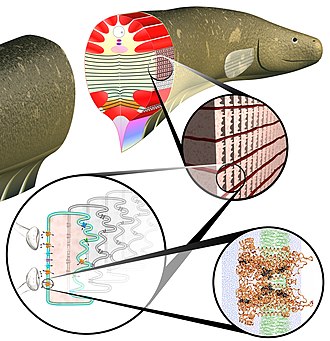Electric organ (fish)
Electric organs are derived from modified muscle or in some cases nerve tissue, called electrocytes, and have evolved at least six times among the elasmobranchs and teleosts.[9][10] Since the 20th century, electric organs have received extensive study, for example, in Hans Lissmann's pioneering 1951 paper on Gymnarchus[11] and his review of their function and evolution in 1958.[13] The stack of electrocytes has long been compared to a voltaic pile, and may even have inspired the 1800 invention of the battery, since the analogy was already noted by Alessandro Volta.A whole-genome duplication event in the teleost lineage allowed for the neofunctionalization of the voltage-gated sodium channel gene Scn4aa which produces electric discharges.[24] Comparative transcriptomics of the Mormyroidea, Siluriformes, and Gymnotiformes lineages conducted by Liu (2019) concluded that although there is no parallel evolution of entire transcriptomes of electric organs, there are a significant number of genes that exhibit parallel gene expression changes from muscle function to electric organ function at the level of pathways.Electric organ discharges (EODs) need to vary with time for electrolocation, whether with pulses, as in the Mormyridae, or with waves, as in the Torpediniformes and Gymnarchus, the African knifefish.



electric rayTorpediniformesbiologyelectric fishelectric fieldmusclenerve tissueelasmobranchsteleostsnavigationdefencetorpedo rayelectric eelJohn WalshJohn HunterCharles Darwinconvergent evolutionOn the Origin of SpeciesHans Lissmannelectroreception and electrogenesisGymnarchus niloticusHistory of bioelectricityelectric catfishancient EgyptRoyal SocietyHugh WilliamsonLuigi GalvaniAlessandro Voltanatural selectionCarl SachsHunterdiscovered in the 1770selectrolocationgymnotidsGymnarchusTorpedo californicaacetylcholine receptorElectrophorusvoltage-gated sodium channelelephantnose fishMormyridaemarinestargazerstorpedo raysmormyridGymnotusSkatesRaja montaguiAstroscopus y-graecumpumping sodium and potassiumcell membranesadenosine triphosphatePostsynapticallymuscle cellsnicotinic acetylcholine receptorsvoltaic pilebatteryion channelscell membranenerve cell'sneurotransmittersproteinteleostelasmobranchconvergently evolvedGymnotidaeGondwanaskeletal muscleelectrically excitableApteronotusneural tissueSynodontisvoltagescurrentsmedullary command nucleusnucleuspacemaker neuronsacetylcholinevoltage-gated sodium channelsElectro-locationRajidaeEigenmanniaMalapteruridaeUranoscopidaeBiology in fictionNaomi Aldermanscience fictionThe PowerThe Journal of Experimental BiologyWalsh, JohnHunter, JohnDarwin, CharlesOn the origin of species by means of natural selection, or the preservation of favoured races in the struggle for lifeSachs, CarlLissmann, Hans W.BibcodeJournal of Experimental BiologyProceedings of the United States National MuseumElsevierThe GuardianThe Washington PostJamming avoidance responseElectric organAmpullae of LorenziniKnollenorganGymnarchidaeGymnotiformesRajiformesLateral lineMagnetoreception